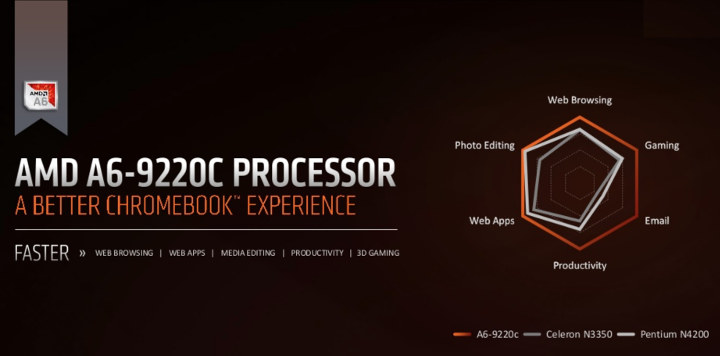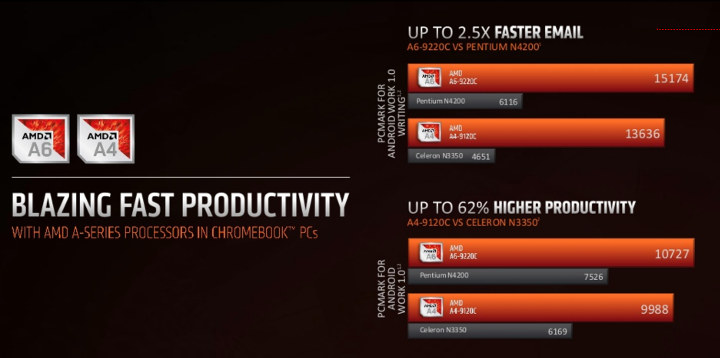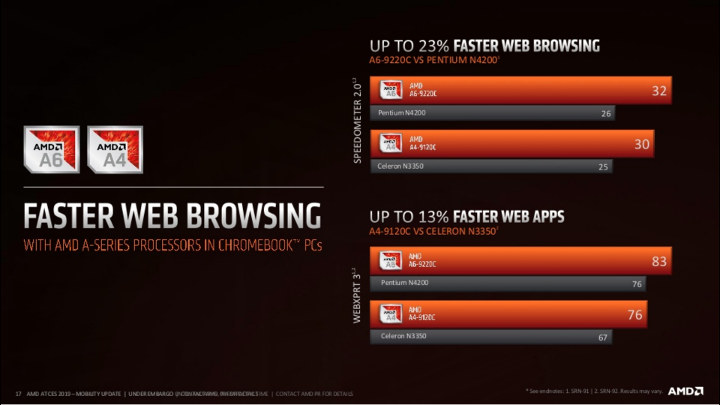Intel will usually release new low power processors under 10W TDP every year, but that has not been the case for AMD, with the company releasing several 12-15W processors in the recent past like Ryzen Embedded V1000 series and the Ryzen 7 2700U processor I’m currently using my Ubuntu laptop.
However, AMD has now announced two new A-series processors with a 6W TDP, namely A4-9120C and A6-9220C dual-core processors that specifically target Chromebooks.

AMD A4-9120C key features:
- Processor – 2x CPU cores, 2x CPU threads @ 1.6 GHz / 2.4 GHz (Boost)
- Cache – 160KB L1 cache, 1MB L2 cache
- GPU – Radeon R4 graphics with 3x GPU Cores up to 600 MHz, support for H.26x, VP9 decode
- Memory – Single channel @ 1866 MHz
- Video Output – HDMI and DisplayPort
- Process – 28nm CMOS
- Package – FT4
- TDP – 6 watts
AMD A6-9220C key features:
- Processor – 2x CPU cores, 2x CPU threads @ 1.8 GHz / 2.7 GHz (Boost)
- Cache – 160KB L1 cache, 1MB L2 cache
- GPU – Radeon R5 graphics with 3x GPU Cores up to 720 MHz, support for H.26x, VP9 decode
- Memory – Single channel @ 1866 MHz
- Video Output – HDMI and DisplayPort
- Process – 28nm CMOS
- Package – FT4
- TDP – 6 watts

Intel’s latest low power entry-level processor family is Gemini Lake, but AMD decided to compare their 7th Gen AMD A-Series processors to the previous generation Apollo Lake processor, and in some specific Android benchmarks the new dual-core AMD processors are much faster than their Intel quad-core counterparts. I’m not quite sure why they decided to run PCMark for Android benchmark on ChromeOS, but nevertheless “writing emails” is 2.5 times faster, and the productivity benchmark is 62% faster. Other benchmarks are also a bit faster with A6-9920C being up to 23% faster for web browsing compared to Intel Pentium N4200, as well as 42% faster for photo editing, and 43% faster for web gaming. They did not compare it to Gemini Lake because the latter would have been faster in some benchmarks, and it’s not good for marketing, and the new AMD A-series pricing looks to be closer to the one of Apollo Lake laptops.

The first Chromebooks to features the new processors will be Acer Chromebook 315 and HP Chromebook 14, expected in early 2019 for prices starting at $280 and $269 respectively. In theory, the new processors should also work with Windows 10 laptops or mini PCs, but AMD only mentions Chromebooks.
Via Liliputing

Jean-Luc started CNX Software in 2010 as a part-time endeavor, before quitting his job as a software engineering manager, and starting to write daily news, and reviews full time later in 2011.
Support CNX Software! Donate via cryptocurrencies, become a Patron on Patreon, or purchase goods on Amazon or Aliexpress





> I’m not quite sure why they decided to run PCMark for Android benchmark on ChromeOS
Easy. Since this benchmark allows the marketing department to spit out numbers where their own CPUs look better than the Intel CPUs they took for comparison.
PCMark uses an interesting approach testing more realistically for real-world performance so it’s great for device comparisons running the same OS but of course totally unsuitable for platform comparisons like this. Storage and memory performance/configuration is important with this benchmark so if your platform should look better the device with your own CPU gets fast storage and memory and the competitor’s CPU runs in a crappy system.
[X]done.Asides that I would never buy such anachronistic technology: ‘Process – 28nm CMOS’ — ‘we all know’ that el cheapo TV box vendor Amlogic is already at 12nm with their dirt cheap TV box SoCs. And these AMD amateurs are still at 28nm. That’s awful! 😉
While 28nm parts have a proven track record in chromebooks, I was wondering how AMD got 15W parts (https://www.amd.com/en/products/specifications/processors/2541,2546,2551,4046,4041,3361,3356,3306,3301,2526,2531,2536,5671,5786,5661,5661) down to 6W, and I think I know now: you shave 600-700MHz off the base CPU clocks. Does not bode well for battery life at those turbo clocks.
>Amlogic is already at 12nm with their dirt cheap TV box SoCs. And these AMD amateurs are still at 28nm.
On the other hand you’re much more likely to get working GPU drivers, video acceleration etc for the 28nm chip in a kernel that was released in the current year.
This was just a joke since for whatever reasons some people really believe dirt cheap TV box SoCs would be using a 12nm process since this number appeared on some ‘leaked’ Amlogic marketing department PDF that has been shared by this site and others…
If i can get these chips in a small stb box with lower than $50 dolar price label, its a perfect solution for android x86 ports.Dont need to wait someone every firmware uptades for every special box. Its x86 and possibly much powerful than amlogic gpus which is based on arm technologies.
gpu≠cpu
Why not compared with Gemini lake? 🙂
There are currently some stock issues with Gemini lake yeah, but they will come back again in following months, and I’m really sure Intel share more for partners such as Acer, Lenovo and others who makes Chromebooks.
When is the last time your e-mail typing speed was limited by the CPU ??? This is totally ridiculous! If there is *one* activity where the CPU cannot make a difference, it precisely is e-mail typing speed… The keyboard can make a huge difference! Except if their CPU is so slow that you have to wait to see your chars echoed on the screen. But clearly I’ve not seen any progress on this front between my 386sx and my quad-core i7. It’s sad that AMD is back to this marketing bullshit to try to hide their shameful failure at delivering a correct CPU. 28nm is antique now, especially for supposedly low-power devices. I don’t know why they’re doing this considering they’ve done good stuff with the Ryzen.
>When is the last time your e-mail typing speed was limited by the CPU ???
I know that’s meant to be a joke but for those of us that use ibus or similar it can be quite painful using very low end processors. Aside from that consider than most people write e-mail in a browser now and all of the javascript running to send your keystrokes to google etc doesn’t run for free.
> I don’t know why they’re doing this considering they’ve done good stuff with the Ryzen.
I’d guess they cannot hit the $270 consumer-product mark with their modern APUs.
What this benchmark does (at least the recent version 2.0 — AMD used the outdated ver 1.0 for whatever reason) is described at https://s3.amazonaws.com/download-aws.futuremark.com/pcmark-android-technical-guide.pdf
The ‘Writing’ benchmark does an awful lot of stuff except of measuring writing speeds 🙂 It’s about document handling, PDF creation, compression… so testing a bit CPU, a bit memory, a bit I/O, a bit Android APIs… really nothing related to e-mail.
Given AMD tested with same ChromeOS version on the Intel Chromebooks at least some performance data can be gathered from their slides. Since they compare with an N3550 (2/2 cores/threads) and an N4200 (4/4 cores/threads) and the latter is not listed as being twice as fast the majority of these benchmarks only tests single-threaded workloads. Since these AMD thingies are dual-core multi-threaded performance will pretty much suck and single-threaded CPU performance might be comparable to an A72 running at slightly above 2.0 GHz.
OK that makes more sense. We’re deeply in the marketing bullshit then, trying to revamp an outdated design that someone found lying on a desk asking “Hey guys who’s this? Nobody? Maybe we should try to sell it before it collects dust then”. They do have the technology available to make a good low-power SoC, they just need to wake up and pull their fingers out of their asses. Let’s hope it happens by 2019, because quite frankly, 6W for something half as powerful as my 1-year-old Atom is exagerated!
I have been waiting for AMD to create some really low power processors since zen1 was released, i wonder whether this is zen, zen+, zen2 or an old cpu architecture. I wonder whether these will support HDR as only intel’s core i series chips support HDR. I wonder whether windows support will be available in addition to chromeos.
These are Excavators.
These are not new APUs and were known from benchmark leaks on Geekbench database years ago. Those charts have benchmarks that will favor single thread performance which is an area where the older Apollo Lake is much weaker. But why not compare with current Gemini Lakes? Because those newer Gemini Lakes are another beast altogether.
So are they Chromebook tweaked versions of these from mid 2017?
https://www.notebookcheck.net/AMD-A4-9120-SoC.279226.0.html
Performance
Because of the significantly lower clock speed, the A4-9120C should be noticeably slower than the old A4-9120. AMD compares the A4-9120C with the Celeron N3350 in ChromeOS and sees a significant performance advantage for the A4. The efficiency however should be clearly worse as the A4-9120C is still manufactured in 28nm.
https://www.notebookcheck.net/AMD-A4-9120C-Processors.392026.0.html
You can find benchmarks here https://browser.geekbench.com/v4/cpu/search?q=Google+grunt+ Basically rebrands of previously leaked and known Stoney Ridge low power 6W versions with -E suffix. More or less Apollo Lake level of performance in single core based on those numbers but certainly not Gemini Lake level of performance. Multi core definitely out of the question because its single module, so those benchmarks AMD used tend to favor single thread and FP performance which are areas the Atom line are weak. But strangely those Geekbench results are mostly in Android 32bit environment whereas can find Gemini Lake results in Android 64bit environment.
I wonder if someone was brave enough to put this suxers to something like TV boxes or SBCs
28nm? I like you AMD, but you’re being retard here.